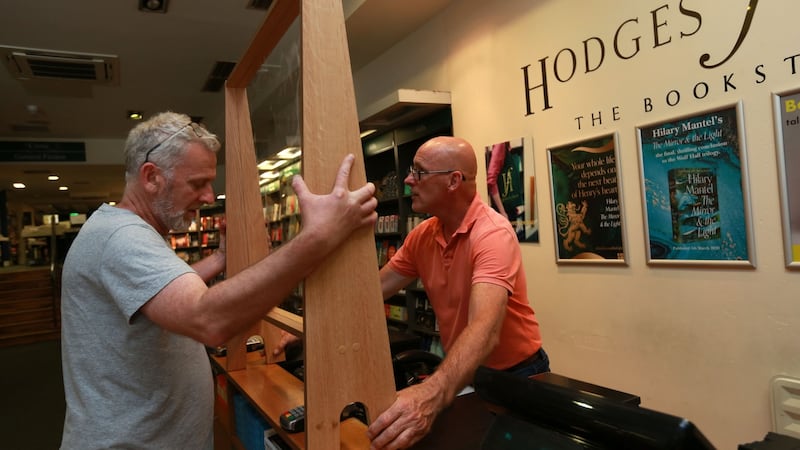“Nobody knows anything.” As bookshops preapre to reopen, a book trade insider quotes the late writer William Goldman on people’s inability to predict what’s going to work best. This has possibly never been more true than in this pandemic.
Timing is always important in publishing success, but luck also has a lot to with it. The pandemic is just another factor in the mix, with publishers having to make a call on whether to publish or postpone a planned book when Ireland shut in March, without knowing until afterwards whether it was the right decision.
Autumn is always the busiest time in the book business, in advance of the Christmas bonanza. And while much of the cultural world has been falling apart, books are probably among the few areas doing okay. But in this year like no other, the structure and timing of publication has been skewed, with two lockdowns and much uncertainty resulting in temporary closures of physical bookshops, cancellations of literary festivals and events, and many books postponed until later in the year or even 2021.
The received wisdom is that this autumn saw a rash of publications, in what trade magazine The Bookseller called a series of “mini-Super Thursdays” in September and October. There were reports of an “onslaught” of more than 600 new books being published in the UK on a single day, September 3rd, up 24 per cent on last year.
For writers and publishers vying for reviews, shelf space and sales, and readers trying to make sense of it all, it sounded like a daunting glut. The reality appears to be more complex. After a shaky period for book sales in Irish shops during the first lockdown, many shops upped their game online, and managed good deals on delivery.
Mind you, observes a hectic Bob Johnston in Dublin’s Gutter Bookshop, “online is twice the work for half the money”. And while online book sales increased during lockdown, and many booksellers report people supporting local shops, a large proportion of online business went to Amazon rather than real bookshops; the Bezos behemoth is always cagey about figures but one book trade observer speculates privately that Amazon may have doubled its sales over the pandemic.
There must be hope that the balance can shift when bookshop.org – the new online independent US bookshop alliance that expanded into the UK this month, in a bid to unite independent shops and rival Amazon in online book sales – launches for Irish bookshops next year.
It was a busy time for bookshops catching up after reopening in June, with lots of new titles through summer and especially in September and October, coupled possibly with a rush to buy before the second lockdown and early Christmas shoppers echoing the queues at toyshops, and sales were very good.
In managing the “onslaught”, many local bookshops tailor what they promote to their knowledge of their own customers. Cian Byrne in Maynooth Bookshop says it’s been very challenging keeping on top of “the volume of titles that are coming at us this year”, with shelf space at a premium, and they’ve had to make harsh decisions about what to stock.
“I feel most sorry for authors. Titles that might do well at other times might struggle this year because of the sheer volume at one time. Hopefully a longer lead into Christmas might allow some of those hidden gems to rise.” The lockdown and post-lockdown surge tapered off and he’s apprehensive about the rest of the year, particularly with their university bookshops affected by online lectures.

Joanna Hamilton of Bridge Street Books in Wicklow says footfall was lower in August, but “when the first batch of new titles arrived en masse in September, it was difficult to display them well. Then, with even more arriving, it was very difficult to give them all fair shelf space.” Sales are up with so many new titles, and she reports people supporting local shops, but she says storage is limited, too, which is needed for high publicity titles.
Village Bookshop in Terenure is also small, with limited space and buying power, so it has to be selective, says Alice Walsh. It tries to anticipate interest but “with so many titles, it can be difficult to predict what will be in huge demand – we could’ve sold three times the number of Two Words for Field we had.”
Outstanding Irish titles
With many outstanding new Irish titles this autumn, “we could fill the shop with them alone, never mind the international books we’d like to stock”, says Walsh. The knock-on is that, whereas books such as Donal Ryan’s Strange Flowers would have been prominent for a few months, she says, “now they’re being eclipsed by a carousel of new titles” with “an embarrassment of riches with new Irish authors and illustrators in fiction, non-fiction, sport and children”.
Book sales did especially well in September and October (particularly children’s fiction and textbooks, and adult non-fiction), the trade reports, though sales for the year to date are relatively flat compared with 2019. According to Nielsen BookScan, printed book sales in Ireland in the second half of 2020 (June 28th- October 31st) totalled 4.8 million copies (up 8 per cent on 2019), valued at €59.1 million (up 11 per cent). As the second lockdown approached, sales grew across adult fiction, adult non-fiction and children’s.
But contrary to a widespread sense of a book glut this autumn, Nielsen says about 19,500 titles were published in the UK and Ireland in September and October 2020 – down some 1,500 on the same period last year. In the UK, says Nielsen, most books cancelled or postponed early in the year tended to shift into July-August rather than autumn. The numbers for October are actually marginally down year on year.
Philip Stone, media manager with Nielsen, senses there was confusion around the number of books published on Super Thursday, with The Bookseller referring to hardbacks only, and lack of clarity around the first Thursday in October – traditionally Super Thursday – which coincided with many academic and small publishers’ default publication on the first of the month. “Very quickly it became very misleading.”

In fact there were, for example, 1,190 fewer hardbacks and paperbacks published in the UK in September than the same month last year. “Mini Super Thursday” (September 3rd) had 486 fewer publications than last year, though on Super Thursday (October 1st), 2,557 books were published, up from 1,196 last year.
“Covid perhaps affected publication numbers in April-May and these were largely pushed to June,” Stone observes. “Generally, although the sales figures are relatively flat year on year, certainly Covid has affected some areas of the book industry harder than others, with staff on furlough, other made redundant. So no doubt many books will have been cancelled or postponed indefinitely, perhaps accounting for the downturn in numbers for August-September.”
And yet, and yet. Anecdotally many in the book trade reflect that there are more books, and very high-quality titles, for sale this autumn. Irish Times books editor Martin Doyle says: “My instinct is there are as many and probably more books coming out this season, as a lot of titles were postponed from earlier in the year. It has got more challenging to find space for reviews.”
Joanna Hamilton of Bridge Street Books echoes that. “Smaller authors and publishers do lose out on space and they definitely lose out on publicity.”
Moving dates
Michael McLoughlin, managing director of Penguin Random House Ireland, says while “the media is as supportive of books and authors as they ever were, it’s harder for some books to get exposure or review space, because there are simply more books out there this year.” He tots up: they published 12 books from September to November (though just one was a postponement) compared with nine in the same period last year.
Nicki Howard, director of publisher Gill Books, agrees. “Undoubtedly, there have been a huge amount of releases in September and October. But what books! They have really kickstarted a great buzz around books, bookshops and reading as the autumn draws in.”
For Gill, “Fortunately, the bulk of our publishing is in the autumn, so we didn’t have a lot of titles left to release in the spring when the restrictions came into place. We paused for a bit to see what was happening – the thought of releasing a book with bookshops closed was scary – and then made our decisions. In the end we only moved two books, one into autumn and one next year.”
Moving publication dates has also affected in different ways on authors, particularly those whose publication was hit by the first lockdown. Hilary Fannin’s first novel, The Weight of Love, was published on March 18th as the country shut down, and while the launch was cancelled, it got good publicity and was widely reviewed.
“I feel lucky and unlucky,” says Fannin. “Weirdly, as bookshops closed, The Weight of Love ended up on display in windows, a bit like musical chairs [when the music stops]. It sold okay during lockdown, strongest online. It had its brief moment in the sun, but the clouds came in very quickly. I consider myself lucky, and I feel for writers struggling in the big melee now.”
Citing how hard booksellers worked to get books out, Fannin says: “They are the lungs of the books world”. She’s aware some writers are “finding it much tougher to get reviews or space on shelves. I’d hate to be bringing a book out this autumn, it would be soul-destroying.”
With literary festivals cancelled, Fannin missed the chance to meet writers and readers: “I didn’t get that rush of adrenalin.” Restrictions mean time to write, but the quiet and uncertainty are a challenge. “You need confidence. Optimism as well as discipline.”
Strange experience
For Elaine Feeney, whose novel As You Were was moved from April to August, publishing during the pandemic was a strange experience, without a launch, signings or tours and few live readings.
“It is a difficult time for everyone, so it’s almost my guilty secret that among the madness and terrible pandemic, I was worried for my own book. That said, we live very much in our own space, and my book took years to write, so I was looking forward to the social aspect of publication. I never had as many festival bookings, and then cancellations. I just hope books find a way into the hands of readers, and that bookshops are supported.”

Pushing out publication was a strange experience and “personally I found it hard to muster the energy the second time around. There was such a huge number of books published in one week, but I was lucky to still get the column inches for reviews, and window displays. I think I was one of the luckier books, and am so grateful for that.”
Conor O’Callaghan’s novel We Are Not in the World was moved from April until next February. Despite “an initial gulp”, it wasn’t really a shock, with the world in turmoil. “I now see that was the right thing to do. And I’m really glad it was pushed back that far, as opposed to be sent out in the scrum of this autumn where it really wouldn’t have had a chance. This way my book gets put out into a little bit of open territory and I’m glad of that.”
He and friends whose books suffered the same fate consoled each other, knowing “there was far worse out there and having ‘one’s literary work’ temporarily postponed is way down the list of human suffering!”
We Are Not in the World was printed printed before postponement, so his two copies “sat on my shelf all summer, like ghosts of an old life. Wisely, I parked it and didn’t even open the book. I had an idea for a new thing and lashed ahead.”
Relishing that period between finishing a book and its release (“the happiest time for any writer,” he says), it was liberating “working on a new thing knowing you still had a book in your hip pocket. It felt like a free shot, and that feeling has given the new project real juice. I knew I could take as many risks as I wished with it, as I still had, as Delia Smith says, one I prepared earlier.” (At the end of August he eventually flicked through his hardback copy and was happy that “I wouldn’t change a word”.)
Best-sellers sell better
There may also be a further complication. Drilling down into Nielsen’s figures, while overall sales are actually pretty similar to what they were in 2019, the 20 best-selling books tend to sell many more copies than the top 20 sellers in the same week last year.
Take for example Week 41, in early October. In 2019, the best-selling book (Once, Twice, Three Times an Aisling) sold 1,877 copies; the same week this year, Graham Norton’s Home Stretch sold 4,704 copies. These disparities are replicated down through the list of bestsellers’ sales. While the overall market is flat, with similar volume and value of book sales, the 20 best-selling books in Week 41 last year sold about 14,500 copies, whereas the equivalent 20 bestsellers in the same week this year clocked up nearly 34,000 sales.
It appears that the most popular books have a larger share of book sales. The implication of this is that that less high-profile books are selling fewer copies.
“It looks like a big shift – winner takes all. It’s more of a challenge this year for those books that aren’t at the front of the shop,” one trade observer says. This noticeable shift to the “bigger” books bears out a sense of how the pandemic has affected shopping – more online purchases; a reluctance to linger and browse in shops, which may affect what people buy, even though overall sales are up since June.
It’s hard to see what proportion of books are accounted for by this tendency for high-profile titles to dominate; according to Nielsen the top 1,000 bestsellers in Ireland over past few weeks have accounted for about 40-45 per cent of sales in both volume and value, consistent with last year.
But it chimes with what McLoughlin says. “I’d be worried that books that need more time and word of mouth to get going will find it harder this year because readers can’t spend the time browsing in bookshops that they usually do. And so-called ‘smaller books’ will find it more difficult than they would in another year.”
We don’t know what physical shopping will be like this December, and it may lack some of the theatricality of buying those last-minute presents in bookshops. But McLoughlin notes that the pandemic means “People have appreciated the ability of a book to take you away from the day to day, to give us a break from the world.”




















